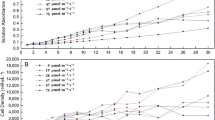Abstract
Atmospheric particulate matter (APM), commonly seen and widely excited in environment, appears great enough to influence the biochemical processes in aquatic microorganisms and phytoplankton. Understanding the response of cyanobacteria to various factors is fundamental for eutrophication control. To clarify the response of cyanobacteria to APM, the effects of PM2.5, PM2.5–10, and PM>10 on Microcystis aeruginosa were researched. Variabilities in cell density, chlorophyll a, soluble protein, malondialdehyde, extracellular activity, and kinetic parameters of alkaline phosphatase were evaluated by lab-cultured experiments. Results showed that the PM2.5 had a slight stimulation impact on the growth and enhanced both of the 48- and 72-h extracellular alkaline phosphatase activity (APA), the affinity of alkaline phosphatase for substrate, and the 72-h maximum enzymatic reaction velocity (Vmax). Moreover, the stimulations in extracellular APA and Vmax enhanced with the increasing exposure concentrations. We also found there were no obvious distinctions on the effects of growth and alkaline phosphatase in M. aeruginosa between PM2.5–10 and PM>10 exposure groups. Obviously, inhibitory effects on growth existed in 4.0 and 8.0 mg/L PM2.5–10 and 8.0 mg/L PM>10 at 120 h. Furthermore, PM2.5–10 and PM>10 exerted inhibitory effects on the extracellular APA during the 72-h exposure. Simultaneously, the Vmax was notably inhibited and the affinity of alkaline phosphatase for substrate was more inseparable compared with control in PM2.5–10 and PM>10 treatments. Nevertheless, the inhibitors in extracellular APA and kinetic parameters were unrelated to PM2.5–10 and PM>10 exposure concentrations. Two-way ANOVA results revealed that there were significant interactions between exposure concentration and diameter of APM on the 120-h cell density, soluble protein content, APA, and 72 h APA of M. aeruginosa. These results in our study would be meaningful to further researches on relationships between APM deposition and cyanobacterial bloom.





Similar content being viewed by others

References
Becagli S, Lazzara L, Fani F, Marchese C, Traversi R, Severi M, di Sarra A, Sferlazzo D, Piacentino S, Bommarito C, Dayan U, Udisti R (2013) Relationship between methanesulfonate (MS-) in atmospheric particulate and remotely sensed phytoplankton activity in oligomesotrophic central Mediterranean Sea. Atmos Environ 79:681–688. https://doi.org/10.1016/j.atmosenv.2013.07.032
Bere T, Tundisi JG (2012) Cadmium and lead toxicity on tropical freshwater periphyton communities under laboratory-based mesocosm experiments. Hydrobiologia 680(1):187–197. https://doi.org/10.1007/s10750-011-0917-8
Berman T (1969) Phosphatase release of inorganic phosphorus in lake Kinneret. Nature 224(5225):1231–1232. https://doi.org/10.1038/2241231b0
Berman T (1970) Alkaline phosphatases and phosphorus availability in Lake Kinneret. Limnol Oceanogr 15(5):663–674. https://doi.org/10.4319/lo.1970.15.5.0663
Chia AM, Lombardi AT, Melão MGG et al (2015) Combined nitrogen limitation and cadmium stress stimulate total carbohydrates, lipids, protein and amino acid accumulation in Chlorella vulgaris (Trebouxiophyceae). Aquat Toxicol 160:87–95. https://doi.org/10.1016/j.aquatox.2015.01.002
Duong TT, Jahnichen S, Le T et al (2014) The occurrence of cyanobacteria and microcystins in the Hoan Kiem Lake and the Nui Cocreservoir (North Vietnam). Environ Earth Sci 71(5):2419–2427. https://doi.org/10.1007/s12665-013-2642-2
Dziga D, Suda M, Bialczyk J, Czaja-Prokop U, Lechowski Z (2007) The alteration of Microcystis aeruginosa biomass and dissolved microcystin-LR concentration following exposure to plant-producing phenols. Environ Toxicol 22(4):341–346. https://doi.org/10.1002/tox.20276
Fitzgerald GP, Nelson TC (1966) Extractive and enzymatic analyses for limiting or surplus phosphorus in algae. J Phycol 2(1):32–37. https://doi.org/10.1111/j.1529-8817.1966.tb04589.x
Francko DA, Heath RT (1979) Functionally distinct classes of complex phosphorous compounds in lake water. Limnol oceanog 24(3):463–473. https://doi.org/10.4319/lo.1979.24.3.0463
Gasparov VS, Degtyar VG (1994) Protein determination with Coomassie brilliant blue G-250. Biochem Mosc 59(6):563–572
Gibson DT, Subramanian V (1984) Microbial degradation of aromatic hydrocarbons. In: Gibson DT (ed) Microbial degradation of organic compounds. Marcel Dekker, New York, pp 181–252
Goldberg IK, Cohen Z (2006) The effect of phosphate starvation on the lipid and fatty acid composition of the fresh water eustigmatophyte Monodus subterraneus. Phytochemistry 67:696–701
Hardy JT, Crecelius EA (1981) Is atmospheric particulate matter inhibiting marine primary productivity? Envir Sci Technol 15(9):1103–1105. https://doi.org/10.1021/es00091a013
Hardy JT, Apts CW (1984) The sea-surface microlayer: phytoneuston productivity and effects of atmospheric particulate matter. Mar Biol 82(3):293–300. https://doi.org/10.1007/BF00392409
Harke MJ, Berry DL, Ammerman JW, Gobler CJ (2012) Molecular response of the bloom-forming cyanobacterium, Microcystis aeruginosa, to phosphorus limitation. Microb Ecol 63(1):188–198. https://doi.org/10.1007/s00248-011-9894-8
Huang BQ, LJ O, Hong HS (2005) Bioavailability of dissolved organic phosphorus compounds to typical harmful dinoflagellate prorocentrum donghaiense Lu. Mar Pollut Bull 51:38–844
Ismail M, Phang SM, Tong SL, Brown MT (2002) A modified toxicity testing method using tropical marine microalgae. Environ Monit Assess 75(2):145–154. https://doi.org/10.1023/A:1014483713719
Jamet D, Amblard C, Devaux J (2001) Size-fractionated alkaline phosphatase activity in the hypereutrophic Villerest reservoir (Roanne, France). Water Environ Res 73(2):132–141. https://doi.org/10.2175/106143001X138787
Juneja A, Ceballos RM, Murthy GS (2013) Effects of environmental factors and nutrient availability on the biochemical composition of algae for biofuels production: a review. Energies 6(9):4607–4638. https://doi.org/10.3390/en6094607
Khan MF, Shirasuna Y, Hirano K, Masunaga S (2010) Characterization of PM2.5, PM2.5–10 and PM>10 in ambient air, Yokohama, Japan. Atmos Res 96(1):159–172. https://doi.org/10.1016/j.atmosres.2009.12.009
Kocak M, Mihalopoulos N, Tutsak E et al (2015) PM10 and PM2.5 composition over the central Black Sea: origin and seasonal variability. Environ Sci Pollut Res 22(22):18076–18092. https://doi.org/10.1007/s11356-015-4928-2
Kong QX, Zhu LZ, Shen XY (2010) The toxicity of naphthalene to marine Chlorella vulgaris under different nutrient conditions. J Hazard Mater 178(1-3):282–286. https://doi.org/10.1016/j.jhazmat.2010.01.074
Kurmayer R, Blom JF, Deng L et al (2014) Integrating phylogeny, geographic niche partitioning and secondary metabolite synthesis in bloom-forming Planktothrix. ISME J 9:909–921
Labry C, Delmas D, Herbland A (2005) Phytoplankton and bacterial alkaline phosphatase activities in relation to phosphate and DOP availability within the Gironde plume waters (Bay of Biscay). J. Experimental Marine Biology and Ecology 318:213–225
Larkum AWD, Douglas SE, Raven JA (2003) Photosynthesis in algae. Kluwer, Dordrecht, p 479. https://doi.org/10.1007/978-94-007-1038-2
Li JH, Wang ZW, Cao X et al (2015) Effect of orthophosphate and bioavailability of dissolved organic phosphorous compounds to typically harmful cyanobacterium Microcystis aeruginosa. Mar Pollut Bull 92(1-2):52–58. https://doi.org/10.1016/j.marpolbul.2015.01.001
Ma XX, Wang SB, Wang YA et al (2015) Vertical migration patterns of different phytoplankton species during a summer bloom in Dianchi Lake, China. Environmental Earth Sciences 74(5):3805–3814. https://doi.org/10.1007/s12665-015-4279-9
Marmen S, Aharonovich D, Grossowicz M et al (2016) Distribution and habitat specificity of potentially-toxic Microcystis across climate, land, and water use gradients. Fronti Microbiol 7:721. https://doi.org/10.3389/fmicb.2016.00271
Mikula P, Zezulka S, Jancula D (2012) Metabolic activity and membrane integrity changes in Microcystis aeruginosa—new findings on hydrogen peroxide toxicity in cyanobacteria. Eur J Phycol 47(3):195–206. https://doi.org/10.1080/09670262.2012.687144
Paerl HW, Otten TG (2013) Harmful cyanobacterial blooms: causes, consequences, and controls. Environ Microbiol 65:995–1010
Pan YP, Wang YS (2015) Atmospheric wet and dry deposition of trace elements at 10 sites in northern China. Atmos Chem Phys 15(2):951–972. https://doi.org/10.5194/acp-15-951-2015
Qian HF, Li JJ, Pan XJ et al (2012) Effects of streptomycin on growth of algae Chlorella vulgaris and Microcystis aeruginosa. Environ Toxicol 27(4):229–237. https://doi.org/10.1002/tox.20636
Rengefors K, Pettersson K, Blenckner T (2001) Species-specific alkaline phosphatase activity in freshwater spring phytoplankton: application of a novel method. J Plankton Res 23(4):435–443. https://doi.org/10.1093/plankt/23.4.435
Rivkin RB (1979) Effects of lead on growth of the marine diatom Skeletonema costatum. Mar Biol 50(3):239–247. https://doi.org/10.1007/BF00394205
Sayler G, Puziss SM, Silver M (1979) Alkaline phosphatase assay for freshwater sediments: application to perturbed sediment system. Appl Environment Microbiol 38:922–927
Song CL, Cao XY, Liu BQ (2004) A relationship between algae blooms and benthic phosphorus status in ponds. Acta Hydrobiologica Sinica 28:7–12
Spijkerman E, Coesel PFM (1998) Alkaline phosphatase activity in two planktonic desmid species and the possible role of an extracellular envelope. Freshwater Bio 39(3):503–513. https://doi.org/10.1046/j.1365-2427.1998.00299.x
Theodosi C, Stavrakakis S, Koulaki F et al (2013) The significance of atmospheric inputs of major and trace metals to the Black Sea. J Mar Syst 109–110:94–102
Wang J, Liu B, Guo N, Xie P (2006) Alkaline phosphatase activity in four Microcystis aeruginosa species and their responses to nonylphenol stress. Bull Environ Contam Toxicol 76(6):999–1006. https://doi.org/10.1007/s00128-006-1017-8
Wang Z, Zhang ZY, Zhang JQ et al (2012) Large-scale utilization of water hyacinth for nutrient removal in Lake Dianchi in China: the effects on the water quality, macrozoobenthos and zooplankton. Chemosphere 89(10):1255–1261. https://doi.org/10.1016/j.chemosphere.2012.08.001
Wang DB, Pakbin P, Shafer MM et al (2013) Macrophage reactive oxygen species activity of water-soluble and water-insoluble fractions of ambient coarse, PM2.5 and ultrafine particulate matter (PM) in Los Angeles. Atmos Environ 77:301–310. https://doi.org/10.1016/j.atmosenv.2013.05.031
Wang P, Cao JJ, Shen ZX et al (2015) Spatial and seasonal variations of PM2.5 mass and species during 2010 in Xi’an, China. Sci Total Environ 508:477–487. https://doi.org/10.1016/j.scitotenv.2014.11.007
Wang SB, Wang YA, Ma XX et al (2016) Effects of garlic and diallyl trisulfide on the growth, photosynthesis, and alkaline phosphatase activity of the toxic cyanobacterium Microcystis aeruginosa. Environ Sci Pollut Res 23(6):5712–5720. https://doi.org/10.1007/s11356-015-5809-4
Yoko O, Inoue T, Yokota K, Ngoc NM (2014) Availability of different phosphorus forms in agricultural soil to Microcystis aeruginosa. Water Sci Technol 69(6):1205–1211. https://doi.org/10.2166/wst.2013.825
Zhou SQ, Shao SY, Gao NY et al (2013) Effects of different algaecides on the photosynthetic capacity, cell integrity and microcystin-LR release of Microcystis aeruginosa. Sci Total Environ 463–464:111–119
Acknowledgements
We thank the anonymous reviewers for their constructive and positive comments.
Funding
This study is financially supported by the National Science and Technology Major Program for Water Pollution Control and Treatment (No. 2012ZX07102-004).
Author information
Authors and Affiliations
Corresponding author
Additional information
Responsible editor: Vitor Manuel Oliveira Vasconcelos
Rights and permissions
About this article
Cite this article
Xu, Z., Wang, S., Wang, Y. et al. Growth, extracellular alkaline phosphatase activity, and kinetic characteristic responses of the bloom-forming toxic cyanobacterium, Microcystis aeruginosa, to atmospheric particulate matter (PM2.5, PM2.5–10, and PM>10). Environ Sci Pollut Res 25, 7358–7368 (2018). https://doi.org/10.1007/s11356-017-0955-5
Received:
Accepted:
Published:
Issue Date:
DOI: https://doi.org/10.1007/s11356-017-0955-5



